Global Wellness Annual Trends Report:
“The Future of Wellness 2022”
EXECUTIVE SUMMARY
Experts identify 10 wellness trends: from a new soil-focused and survivalist wellness—to the men’s body image crisis and women’s health research gap finally getting addressed—to the rise of the wellness metaverse, certified wellness coaches, urban wellness playgrounds, and healthier senior living models
On February 8, 2022, The Global Wellness Summit (GWS) released its annual wellness trends report, illustrating the new directions in wellness that the organization believes will have the most meaningful impact on the industry and people worldwide. The 110-page report goes in-depth on the major shifts ahead in nutrition, wellness travel, wellness real estate, women’s health, men’s wellness, healthcare, technology, sustainability and spas. The trends were unveiled at the first Global Wellness News™ media event in New York City.
The 10 Wellness Trends for 2022:
- Dirt-y Wellness: The Health of the World’s Soil–and the Impact of Soil Exposure on Human Health–Become More Important
- Toxic Muscularity Comes Clean
- From Wellness Tech to Technological Wellness
- Senior Living Disrupted
- Wellness Travel: Seekers, Welcome
- Innovative Tech Closing the Gender Gap in Medical Research
- Urban Bathhouses & Wellness Playgrounds
- Next-Gen Naturalism: The Return of Self-Reliance
- Health & Wellness Coaching Gets Certified
- Wellness Welcomes the Metaverse
“If it’s always daunting to predict trends in the fast-moving wellness space, it’s especially so two years into a pandemic where the long-promised ‘post-pandemic world’ is becoming visible but is repeatedly delayed,” said Susie Ellis, GWS chair and CEO. “One thing that this forecast makes clear is that the future of wellness will be anything but a ‘restart’ of 2019. What consumers now need most, what they perceive as ‘true wellness,’ has profoundly changed.”
A few themes emerge in the trends report. With new awareness of the radical fragility of life and the planet, a “survivalist wellness” is emerging: More people are seeking resilience and self-reliance (see: “Next-Gen Naturalism”) and they’re now keenly aware that their own wellbeing is inextricable from the planet’s (see: “Dirty Wellness,” on how restoring the world’s soil and our connection to it become a major focus).
Another theme is tackling the glaring gaps, missing links, and underserved populations in both healthcare and wellness: from male body issues finally getting the attention that women’s have to innovative technology closing the women’s health research gap to “senior living” getting a dramatic rethink to the rise of professional wellness coaches dedicated to solving that great unsolved issue in both healthcare and wellness: motivating behavior change.
With the pandemic further subsuming us in a digital world, the future of wellness and technology is complex: The metaverse will plunge us into evermore immersive health and wellness experiences while a new “technological wellness” will have us interrogating our relationship to tech as never before. As always, the report covers the cool, new experiences rising in wellness: from pandemic-weary cities being reimagined as accessible “wellness playgrounds” to destinations answering the call of a new purpose-seeking wellness traveler, with experiences that help them grow intellectually, spiritually and creatively.
This is the only wellness forecast based on the insights of hundreds of global executives of wellness companies, economists, doctors, investors, academics, and technologists that gather each year at the GWS. The authors—top journalists, analysts and wellness experts—bring each trend to life with examples of the innovators and companies that are pioneering each concept.
Media can request the full report here.
Non-press can purchase the full report here (which includes virtual access to the 3-hour trends and research event held on February 8).
The 2022 Global Wellness Trends:
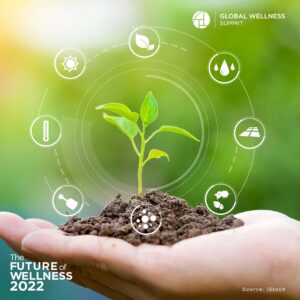 Dirt-y Wellness
Dirt-y Wellness
The health of the world’s soil—and the impact of soil exposure on human health—become far more important (Think: “soil-bathing”)
Soil, that mysterious world underfoot, is our planet’s most extraordinary ecosystem: one handful contains 50 billion life forms. For millions of years, the microbial stew that is living soil did its job: from cycling nutrients to plants to capturing vast amounts of atmospheric carbon.
For 99% of human evolution, people lived deep in soil—as foragers and farmers. Now we’re soil-deprived, no longer bathing in all that bacterial and fungal richness. Mounting research indicates that the soil and human microbiomes are anciently connected, and that soil exposure has an eye-opening impact on everything from immune to mental health.
The problem: we’re in a huge soil crisis, so, a food, environmental and health crisis. Industrial agricultural methods quickly decimated the world’s soil microbiome: one-third of all farmland is intensely degraded.
A new regenerative agriculture—techniques that restore soil’s biodiversity—is the hottest topic in farming and will now become a hot topic in wellness. “Regen,” or “soil-certified,” will be the next food label, because it’s far more meaningful than “organic”—not only for its huge environmental impact but because soil health is the true lens into food’s nutritional value (which has plummeted under both Big Ag and organic farming). More wellness brands will pivot to regen-farm-sourced ingredients. In wellness real estate, regen-agrihoods are a real trend to watch.
We cover the many trends getting people back to some “soil bathing.” Yes, the gardening and foraging manias continue, but more people are becoming serious ag-geeks. An unprecedented greening of the urban landscape and an explosion in urban farms are underway. A new microbial architecture/design is even creating indoor spaces teeming with healthy soil microbes. At more wellness resorts, the farm—and increasingly the regenerative farm—is becoming as important as spa and fitness. We see whole menus of farm-wellness experiences. Think: soil-to-guest, beyond farm-to-table.
The world is waking up to the dire need to rewild the world’s soil and to the soil-human microbiome connection. A “dirty wellness” deliberately refutes wellness’ “clean” obsession: our bodies aren’t gated temples, we’re just a dance between the trillions of microorganisms in the soil and in our gut.
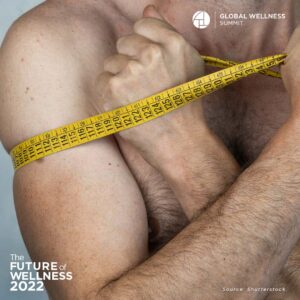 Toxic Muscularity Comes Clean
Toxic Muscularity Comes Clean
How bulging biceps and rippling abs have had a negative ripple effect on male body image
A growing body of research is revealing that body image is no longer solely a “women’s issue.” In April 2021, a survey by a United Kingdom (UK) male suicide prevention charity and Instagram found that half of men aged 16-40 had struggled with their mental health because of how they feel about their bodies—and half pointed the finger at mainstream and social media. “Toxic muscularity” can be literally poisonous. Anabolic-androgenic steroid abuse is hiding in plain sight in the improbable shape of actors, athletes, influencers and action figures. The consequences, both mental and physical (sometimes fatal), could however soon be hard to ignore. And steroids are merely the most notorious of an ever-expanding pharmacopeia of image- and performance-enhancing drugs (IPEDs) that have spread from backstreet gyms to commercial and high-end health clubs to high schools.
Steroids and other IPEDs don’t only impact the men and boys who take them, but also those exposed to chemically enhanced muscular ideals—so basically all of them (not to mention digital manipulation). Toxic muscularity is contributing to the rise in male eating disorders and muscle dysmorphia (also known as “reverse anorexia” or “bigorexia”): the pathological preoccupation that you’re not muscular enough, no matter how big and lean you may be.
Thankfully, the male equivalent of the conversation about unhealthily thin female models and Barbie dolls is finally happening—if still underdeveloped.
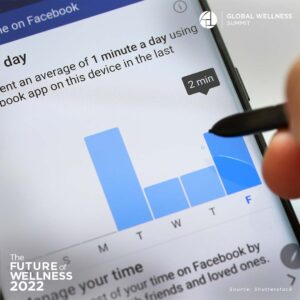 From Wellness Tech to Technological Wellness
From Wellness Tech to Technological Wellness
A fresh take on digital health
Between fitness wearables, telehealth apps, and smart home gyms, there seems to be no shortage of technologies (tech) promising to make us well. But the truth is that most technologies—the technologies that make up the majority of our screen time—are harming our health, not helping it. That’s where the need for technological wellness comes in: A kind of wellness that doesn’t just remedy the toxic toll that tech takes on our minds on bodies, but rather, puts health at the center of how—and how often—we engage with technology at large.
To accomplish this, a new kind of collaboration between the technology industry and wellness industry would be required. The world’s biggest tech companies are already racing to build a world where we interact via virtual reality headsets and trade our glasses for augmented reality contacts. But by pausing, asking the tough questions, and developing everyday technologies with health in mind, we can create a better kind of world: One where we treat our tech intake more like our food intake—taking greater care to understand how it affects our mind, body, and overall wellbeing.
 Senior Living Disrupted
Senior Living Disrupted
A wrinkle in time no more!
For years, it’s been said that 60 was the new 40. But now, according to leading aging experts, 90 will be the new 40 within a decade. The exponential jump in longevity means that people are retiring later and focusing on being active and engaged with personal growth into old age. Healthier, more youthful, and more active than their cohorts in previous generations, this incoming senior class doesn’t “feel old” and doesn’t want to be defined by age, nor socially segregated by it. That’s why today’s age-segregated models of senior living communities are no longer cutting it with a new generation that doesn’t believe in the concept of being put out to pasture upon retirement.
To meet the changing expectations of aging adults, we believe “senior living” (a term that we would like to see retired) will, and needs to, focus more on intentional intergenerationality. This goes back to “days of yore,” when people were not so transient, and communities stayed organically intergenerational. Such old-school intersectionality still exists in the world’s Blue Zones—places like Okinawa, Japan and Sardinia, Italy—which also happen to be among the places where people live the longest and age the healthiest.
In this trend report, we examine new models for intergenerational living environments that can set the stage for reducing age segregation, while increasing social connections, decreasing loneliness, and resulting in better health and wellbeing outcomes for all residents. We look at the development of pocket neighborhoods; innovative, mutually beneficial intergenerational co-living models; and strategies for designing for intergenerationality.
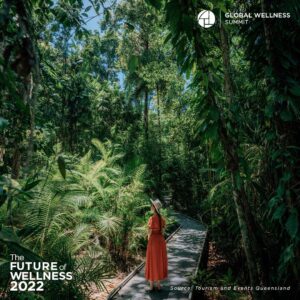 Wellness Travel: Seekers, Welcome
Wellness Travel: Seekers, Welcome
Post-pandemic travelers are ready for adventure and engagement
Intention is the future of travel in 2022. Social indicators such as the “great resignation,” record retirements and global nomadism reveal profound commitments to work/life balance and personal growth and happiness. In fulfilling those goals, the travel industry is rolling out the welcome mat for these new intentional travelers with the invitation: Seekers, welcome.
New travel experiences tap into a sense of purpose, a desire to grow creatively and intellectually and flourish in new environments. Nature as a healer and a source of awe remains primary, whether at a rooftop yoga class or trekking the forthcoming Trans Bhutan Trail. Seekers will be exploring the wisdom of the ancients in Indigenous travel experiences; learning to grow their own food; expressing their creativity in art classes; and giving back to academia in citizen science programs.
The pandemic underlined the need to attend to personal health and taking a break—also known as a vacation—became a bigger part of the wellness picture. In 2022, it’s clear that the thread of wellness is so braided into the travel world that nearly every trip is an opportunity for travelers to reclaim their lives, improve their health, and discover their purpose.
 Innovative Tech Closing the Gender Gap in Medical Research
Innovative Tech Closing the Gender Gap in Medical Research
Artificial Intelligence (AI), apps, and wearables collect data for a wide range of women’s health conditions
Too many women’s health conditions are underfunded and under-researched. This has led to major issues in healthcare: women with chronic conditions have a harder time securing a correct diagnosis and finding effective treatments, thereby impacting their view of mainstream medicine. Patients wonder: why aren’t there more solutions out there?
Startups and technology giants are increasingly trying to expand and improve research data through AI, smartphone apps, wearables, and virtual trials. From data-gathering trackers to “smart bras,” Silicon Valley is reimagining a host of existing technologies. These new advancements allow for better representation in trials, quicker access to participants, and more longitudinal data. Research institutions and academia are starting to show interest, partnering with a wide range of startups, proving there’s more than one way to collect health information.
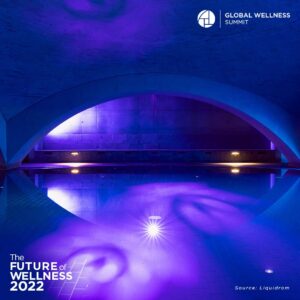 Urban Bathhouses & Wellness Playgrounds
Urban Bathhouses & Wellness Playgrounds
Affordable wellness is coming to a city near you
Whether it’s new or renovated bathhouses featuring hydrothermal bathing (saunas, steam rooms, pools, etc.); large-scale wellness water resorts (some of which accommodate up to 8,000 visitors daily); or public parks where nature meets art and wellness, cities around the globe are suddenly making the pursuit of wellness accessible, affordable and inclusive.
Communal bathing that hearkens back to European and Asian bathing cultures is inspiring an urban bathhouse renaissance around the globe. Just a few examples: Austria’s Therme Group, which already attracts around 3.4 million visitors a year to its sites in Europe, is now investing heavily in North America; Italian wellness company QC Terme will open its next urban bathhouse on New York’s Governor’s Island; and a Finnish-inspired Nordic bathing spa opened in early 2022 in Toronto.
Additionally, sauna bathing (and communal sweating) is becoming more popular and playful—it’s less about being serious and silent and more about communal joy! Large event saunas have been opening outside of European sauna “hot spots,” with cities like Las Vegas hosting high-octane “Sauna Aufguss” performances and London night spots offering private rooftop saunas adjacent to the rooftop bar.
New public playgrounds that merge nature and art with wellness are transforming cityscapes—with new manmade beachfronts, scenic boardwalks, pop-up wellness classes, and even water sports becoming available in very unexpected places: like New York, Paris, London, Sydney, Madrid, Tokyo, and more.
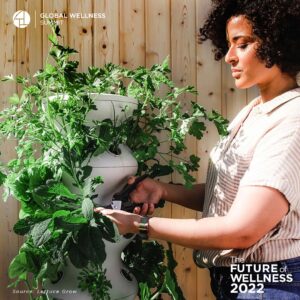 Next-Gen Naturalism
Next-Gen Naturalism
The return of self-reliance
For decades, the concept of progress has been about requiring humans to do as little as possible. We praise automation, reward the businesses who deliver convenience on-demand, and admire nature from a safe distance—glorifying it without respecting it. But the looming threat of global upheaval is forcing us to change our ways. As we collectively reckon with the fragility of our planet and the instability of our supply chains, we’ll see a long-overdue return to self-reliance.
This self-sufficiency boom is already evident in the global growth of outdoor survival schools, foraging, homegrown produce, and TikTok #ecohacks. And it’s a trend that’s very much in line with the larger shifts towards back-to-basics wellness. Just as wellness is returning to the fundamentals, Next-Gen Naturalism requires a Marie-Kondo-esque simplification of one’s life and consumption, placing a refreshing focus on the natural world and ancient practices. It’s a no-frills kind of wellness that forces us to rethink how we use our natural resources, how we source our food, and ultimately—how we prepare for a shaky future. Because in unpredictable times, preparedness equals peace of mind.
 Health & Wellness Coaching Gets Certified
Health & Wellness Coaching Gets Certified
Coaches trained in the art and science of motivating healthy changes have been the missing link in both healthcare and wellness
The world spends $8.3 trillion a year on healthcare, $4.4 trillion on wellness, but we can’t stem the tide of chronic diseases. Behavior change is the toughest nut. So, why haven’t coaches devoted to helping people make healthy changes been at the center of everything? They’re a no-brainer, they’ve been absent, but now the certified health and wellness coach (HWC) is finally here.
In the Wild West of “wellness coaching,” the future is new distinctions, because what a certified HWC does is utterly unique. They’re healthcare professionals trained in evidence-based, nuanced conversational techniques that get people developing the intrinsic motivation and confidence to hit realistic wellbeing goals. Unlike the 15 minutes doctors give you, they spend time: around 50 minutes a week for at least 3 months. Their approach is radically different from the “prescriptive” model that rules both medicine and wellness. Doctors say exercise; wellness gurus say follow me on this path to weight loss or enlightenment. These coaches check advice-dispensing at the door because prescriptive models have failed spectacularly. Motivation must be sparked from within.
This trend explores how these coaches are poised to explode; how rigorous training and certification programs are now in place; how more insurance companies are covering. Primary care startups (like Vera Whole Health) and public health initiatives (like the National Health Service’ “Personalised Care” plan) are shaking up medicine with “care team” models, where this coach is as central as the doctor. We look at the avalanche of digital health companies promising to revolutionize everything from chronic disease management to weight loss by automating “personalized health coaching”—and problems with all the coach-bots coding the human out of the process. Wellness resorts, working on the “hi-and-bye” and “a week can change your life” models, have resisted HWCs. We see change: resorts like Mexico’s Cartesiano are now incorporating them and Six Senses and Canyon Ranch are opening urban wellness centers for more “everyday” coaching.
More doctors argue these coaches need to be central to all primary care. They also need to become more central in wellness. Why are wellness devotees always chasing the next diet or influencer? Because behavior change comes from within. Certified HWCs will increasingly work with doctors, insurers, employers, physical therapists, fitness trainers, and people independently. Because they are the missing link.
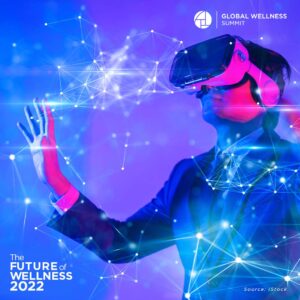 Wellness Welcomes the Metaverse
Wellness Welcomes the Metaverse
Health & wellness are attractive to the Metaverse which needs to diversify beyond gaming
The metaverse is happening…it isn’t a maybe. And thanks to a wide range of social forces, including the pandemic, the rise of the “Wellness Metaverse” is inevitable. With wellness front and center in consumer’s minds—and at the forefront of business and government strategies around the globe—the world is seeking new technologies that can far better engage and impact the health of many more people. From virtual reality and augmented reality to merged reality and haptics, the coming wellness metaverse will create vast opportunities for each sector of the $4.4 trillion global wellness economy.
To build a Wellness Metaverse, there will be unprecedented new synergies between the technology, wellness and health industries. Wellness sectors, including fitness, beauty, healthy eating, mental wellness, wellness tourism, wellness real estate, spas and workplace wellness are introducing new technologies and virtual worlds that deliver a far more immersive experience and radically transform how wellness is delivered to global consumers. And the entire world is paying attention. Fortune 500 companies are unveiling creative, disruptive new products and services that can improve people’s health and lives. The coming metaverse will move beyond gaming and health and wellbeing will be at the center—it will prove one of its meaningful bright spots. And it’s a bright future where the wellness industry can play a leadership role.
About the Global Wellness Summit —The Global Wellness Summit is the premier organization that brings together leaders and visionaries to positively shape the future of the $4.4 trillion global wellness economy. Its future-focused conference is held at a different global location each year and has traveled to the United States, Switzerland, Turkey, Bali, India, Morocco, Mexico, Austria, Italy and Singapore. GWS also hosts regular virtual gatherings, including Wellness Master Classes, Wellness Sector Spotlights and Investor “Reverse Pitch” events. The organization’s annual Global Wellness Trends Report offers expert-based predictions on the future of wellness. The 2022 Summit will be held in Tel Aviv, Israel from October 31-November 3.
